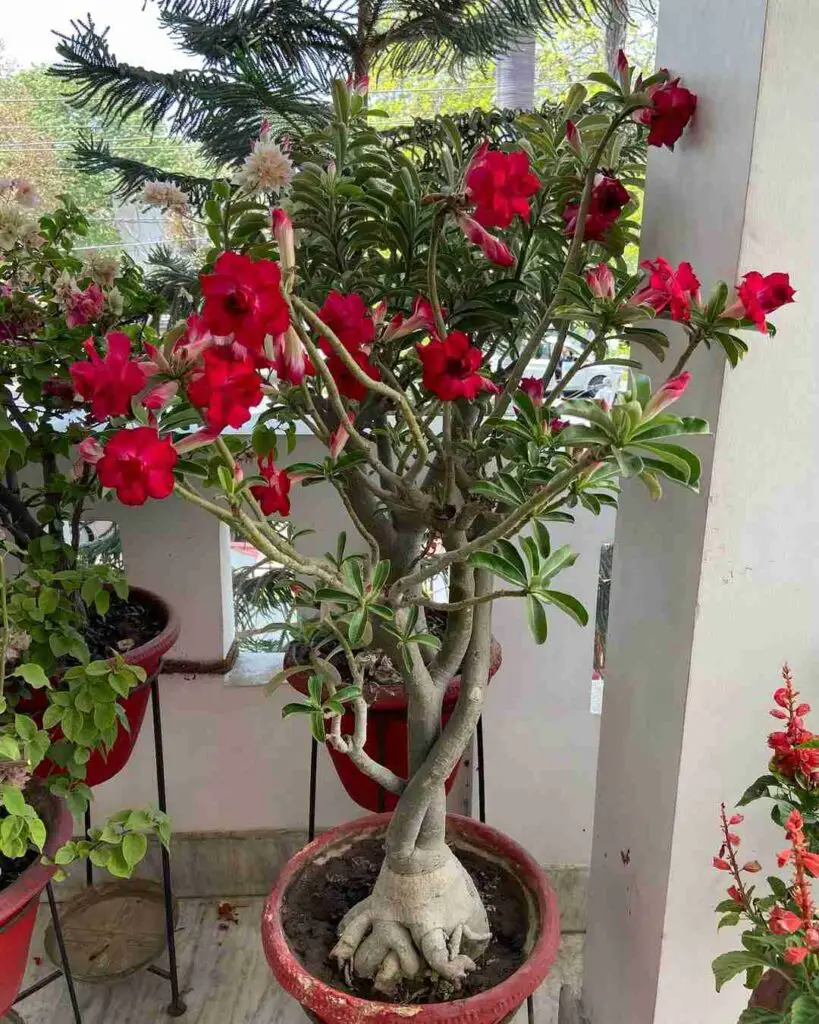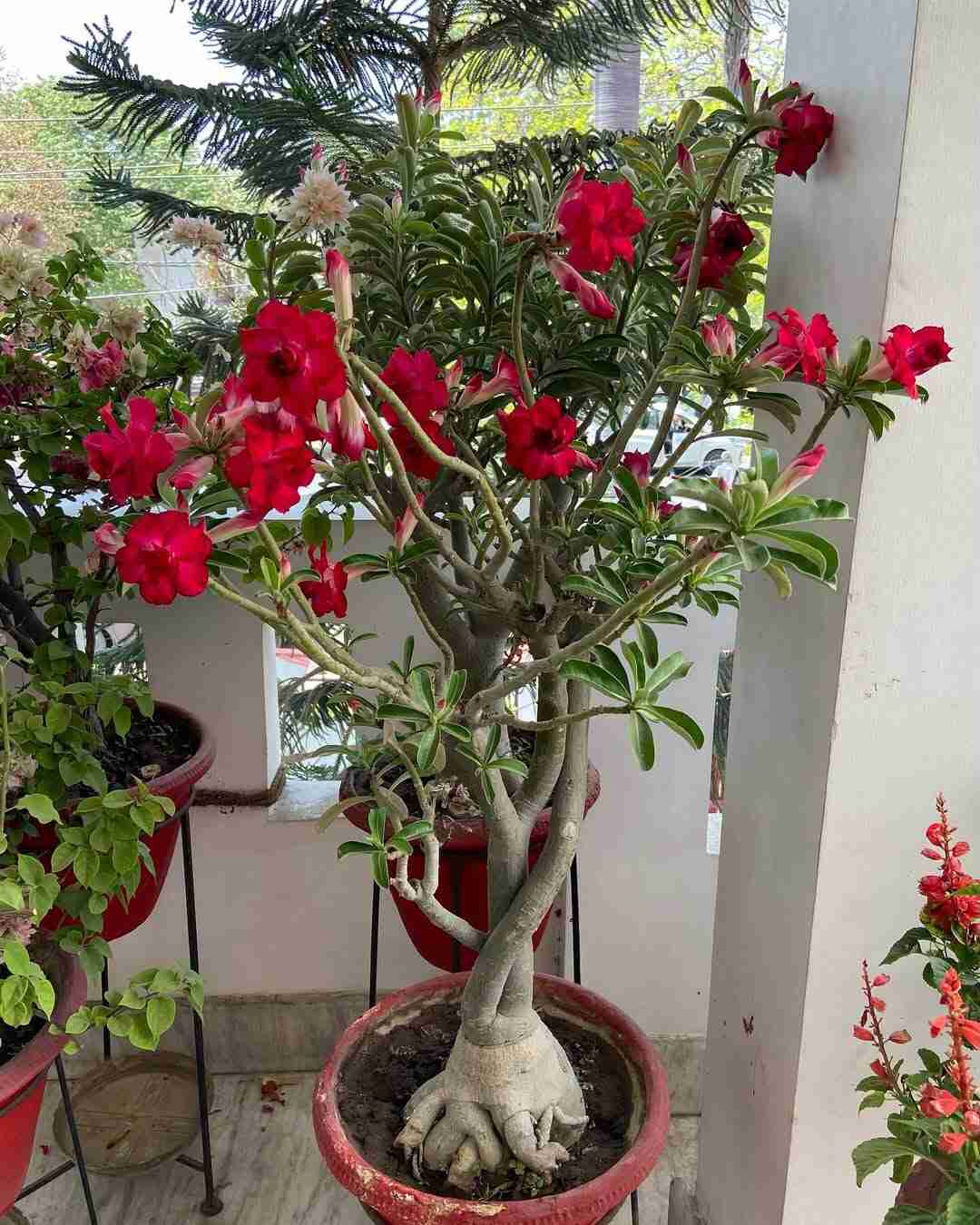Growing a desert rose without a moss pole is entirely possible with the right care and attention. If you’ve been wondering how to grow a desert rose without a moss pole, this article will walk you through practical methods that help your plant thrive naturally. Moss poles are often unnecessary for this type of succulent.
Instead, you can encourage healthy growth by focusing on proper soil, sunlight, and pruning techniques. The desert rose, known for its thick trunk and vibrant blooms, naturally grows upright when given the right conditions. Let’s explore how to support its structure without the use of any pole.

Best Pot and Soil for Desert Rose Growth
Selecting the right pot and soil is crucial when growing a desert rose without a moss pole. This plant relies heavily on its root system and base stability, so your container and soil choices must support its structure and promote healthy development.
Choose the Right Pot:
- Well-Draining Material: Opt for terracotta or unglazed ceramic pots, which allow excess moisture to escape.
- Proper Size: Use a pot that is only slightly larger than the root ball. A snug fit encourages root strength and prevents toppling.
- Drainage Holes: Ensure the pot has at least one good drainage hole to prevent waterlogging, which can lead to root rot.
Soil Mix That Works:
- Cactus or Succulent Mix: These are specially designed for arid-loving plants and provide excellent drainage.
- DIY Option: Combine equal parts potting soil, coarse sand, and perlite or pumice.
- Avoid Heavy Soils: Clay-rich or moisture-retentive soil can lead to poor root health.
A sturdy pot and gritty, fast-draining soil help your desert rose develop a strong base. This is especially important when you’re not using a moss pole for support. A well-anchored plant is less likely to lean or become unstable over time.
Smart Watering Tips for Desert Roses
Knowing how to water your desert rose properly is key to its health—especially when you’re not using a moss pole. Too much water can cause root rot, while too little can lead to dehydration and poor flowering.
Stick to a Drying Cycle:
- Let Soil Dry Out: Always allow the top 1–2 inches of soil to dry before watering again.
- Check with Your Finger: Gently insert your finger into the soil; if it feels dry, it’s time to water.
- Adjust Seasonally: Water more during active growth in spring and summer, and reduce drastically in fall and winter.
Watering Techniques That Help:
- Deep, Infrequent Watering: Water thoroughly until it drains out the bottom, then wait until the soil is dry before repeating.
- Avoid Overhead Watering: Keep water off the foliage and stem to prevent fungal problems.
Signs of Watering Issues:
- Overwatering: Yellowing leaves, soft stems, and root rot.
- Underwatering: Wrinkled leaves and a shriveled caudex (swollen base).
Consistent but minimal watering strengthens the root system, helping your plant remain upright naturally without needing external support.
Ideal Light and Temperature for Desert Rose
Providing the right lighting and temperature is essential for growing a desert rose without a moss pole. These conditions directly influence the plant’s growth habit, flower production, and structural strength.
Give It Plenty of Sunlight:
- Full Sun Preferred: Desert roses thrive in 6–8 hours of direct sunlight daily.
- Indoor Placement: If growing indoors, place it near a south-facing window or use grow lights to supplement natural light.
- Rotate the Pot: Turn the pot regularly so the plant grows evenly and doesn’t lean toward one direction.
Keep Temperatures Warm:
- Daytime Range: Ideal temperatures fall between 70°F and 90°F (21°C–32°C).
- Nighttime Drop: Temperatures can safely dip to 60°F (15°C) at night, but not much lower.
- Avoid Cold Stress: Protect your plant from temps below 50°F (10°C), especially in winter.
Quick Tips:
- Too little light leads to leggy, weak stems.
- Sudden cold drafts can cause leaf drop.
- Stable warmth promotes a compact, upright form.
With steady warmth and strong light, your desert rose will grow sturdy and upright—without needing a moss pole to keep it standing tall.
Feeding Your Desert Rose the Right Way
Fertilizing plays a key role in growing a strong, healthy desert rose without the support of a moss pole. The right nutrients help build a robust caudex and encourage balanced growth.
Use the Right Fertilizer:
- Balanced Liquid Fertilizer: Choose a balanced formula like 10-10-10 or 20-20-20.
- Low-Nitrogen Option: During flowering season, switch to a low-nitrogen, high-phosphorus formula to boost blooms.
- Water-Soluble is Best: Liquid fertilizers are easy to apply and absorb quickly.
How Often to Fertilize:
- Growing Season: Feed every 4–6 weeks from spring through early fall.
- Dormant Months: Skip fertilizing in winter when the plant slows down.
Application Tips:
- Dilute Properly: Use half the recommended strength to avoid fertilizer burn.
- Water First: Always water lightly before fertilizing to protect the roots.
- Avoid Leaf Contact: Apply directly to the soil to prevent foliage damage.
By feeding your plant regularly but not excessively, you encourage compact growth and sturdy branches. This helps maintain the desert rose’s form without needing vertical support from a moss pole.
How to Prune and Shape for Strength
Pruning and shaping are essential for maintaining a balanced, self-supporting desert rose. Without a moss pole, careful trimming encourages bushier growth and a stronger, upright structure.
Why Prune Your Desert Rose?
- Encourages Branching: Cutting back long stems stimulates new side shoots, resulting in a fuller shape.
- Removes Weak Growth: Trimming away thin, leggy stems helps the plant conserve energy and stay stable.
- Improves Airflow: Proper pruning prevents fungal issues and promotes overall plant health.
When and How to Prune:
- Best Time: Prune in early spring before new growth begins.
- Use Clean Tools: Always sterilize your shears to avoid spreading disease.
- Cut Above a Node: Make cuts just above a leaf node or branch junction.
Shaping Tips Without a Pole:
- Balance the Structure: Keep growth evenly distributed to prevent leaning.
- Pinch New Tips: Lightly pinching soft tips helps control height and shape.
- Remove Suckers: Trim off any unwanted basal shoots that sap energy from the main stem.
Regular shaping not only enhances your desert rose’s appearance but also reinforces a strong, stable frame—making external support unnecessary.
Keeping Pests and Diseases Under Control
Keeping your desert rose healthy without a moss pole means managing pests and diseases that can weaken its structure. Unchecked infestations can stress the plant, making it more likely to droop or develop soft stems.
Common Pests to Watch For:
- Aphids: Small green or black insects that cluster on new growth.
- Spider Mites: Fine webs and yellow speckling on leaves signal their presence.
- Mealybugs: White, cottony masses usually found in stem joints.
How to Manage Them:
- Manual Removal: Wipe off pests with a damp cloth or use a soft brush.
- Neem Oil or Insecticidal Soap: Apply weekly until pests are gone.
- Isolate Infected Plants: Keep affected plants away from others to prevent spread.
Recognizing Disease Issues:
- Root Rot: Caused by overwatering—look for mushy roots and a rotting smell.
- Leaf Spot: Fungal or bacterial spots on leaves that may lead to yellowing or drop.
- Stem Rot: Soft, blackened areas on the stem indicate fungal infection.
Preventive Steps:
- Don’t overwater
- Ensure good air circulation
- Use sterile tools when pruning
A pest- and disease-free desert rose stays strong and upright, holding its form naturally without any artificial support.
Designing a Desert Rose Display That Stands Out
Even without a moss pole, your desert rose can be a showstopper in any plant arrangement. With thoughtful placement and complementary greenery, you can create a stunning, natural display that highlights your plant’s unique shape and structure.
Showcase the Desert Rose:
- Use a Decorative Pot: Choose a stylish container that complements the plant’s sculptural look.
- Centerpiece Option: Place your desert rose in the center of a patio table, shelf, or plant stand to draw attention.
- Elevated Positioning: Keep it slightly elevated to emphasize its bold caudex and upright posture.
Pair With Suitable Plants:
- Succulent Companions: Surround it with low-growing succulents like echeveria or haworthia.
- Minimalist Look: Let your desert rose shine on its own in a clean, uncluttered space.
- Color Coordination: Use pots, stones, or décor that echo the flower colors—pinks, reds, or whites—for visual harmony.
Design Tips:
- Keep lighting uniform across all plants.
- Leave enough space for airflow and light penetration.
- Use gravel or decorative stones as top dressing to finish the look.
A well-styled setup turns your desert rose into a thriving focal point—proving that with the right care and creativity, you don’t need a moss pole for beauty or structure.
Easy Ways to Propagate a Desert Rose
Propagating your desert rose allows you to grow new plants without needing moss poles for support. With the right technique, you can create strong, upright specimens right from the start.
Methods of Propagation:
- Stem Cuttings: The most common and quickest way to propagate.
- Seeds: A slower method, but great for developing a thick caudex from the beginning.
Stem Cutting Propagation:
- Select a Healthy Stem: Choose a mature, non-flowering branch.
- Make a Clean Cut: Use sterile shears to snip a 5–6 inch section.
- Dry It Out: Let the cutting dry for 2–3 days to prevent rot.
- Plant in Dry Soil: Insert into well-draining cactus mix and water lightly.
Seed Propagation Tips:
- Use fresh seeds for better germination.
- Keep the soil warm (around 80°F) and lightly moist.
- Provide bright light during sprouting.
Care After Propagation:
- Avoid overwatering young plants.
- Gradually introduce full sunlight.
- Fertilize lightly once growth begins.
Whether from cuttings or seeds, your new desert rose plants can grow sturdy and upright with proper care. No moss pole needed—just good soil, light, and patience.
Final Thoughts
Growing a desert rose without a moss pole is simple when you focus on the basics—pot selection, soil, light, water, and pruning. With a bit of care, your plant will naturally develop strong, upright growth and vibrant blooms, making it a standout feature in your garden or home.

I’m Shofi, a passionate gardener and blogger. I have 10+ years of experience in gardening and hold certifications in horticulture and garden design. I share my knowledge and skills through my garden blog to inspire and educate others on the joys of gardening. I try to provide valuable information and create a community for gardeners of all levels to connect and learn. My ultimate goal is to inspire others to start their own gardens and connect with nature.

